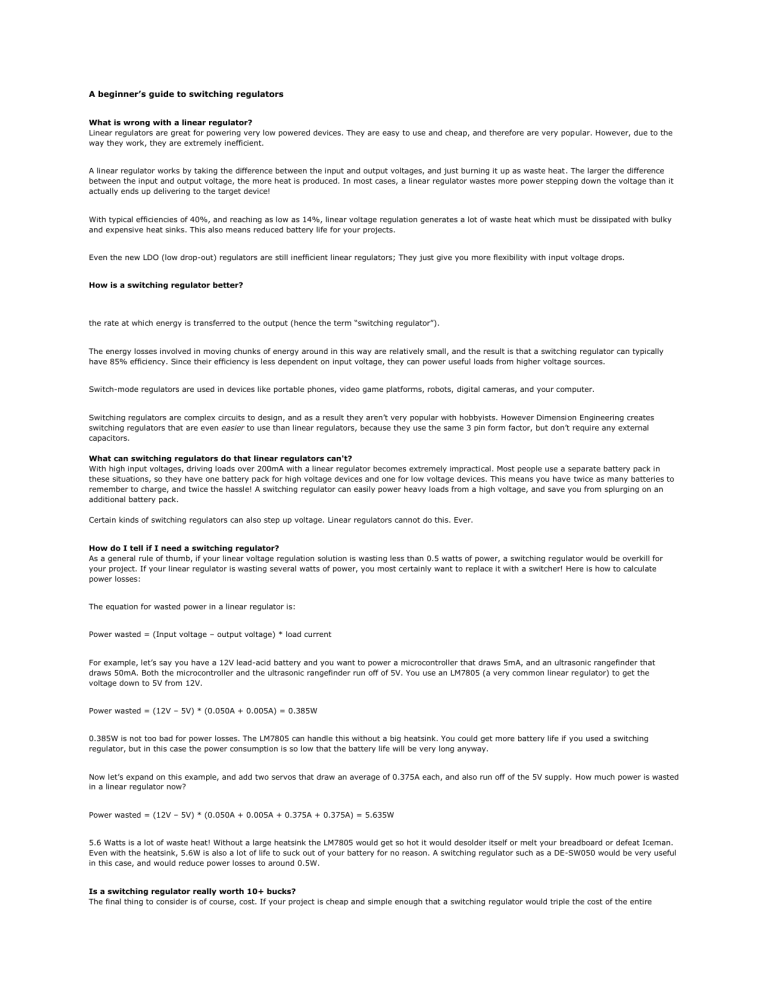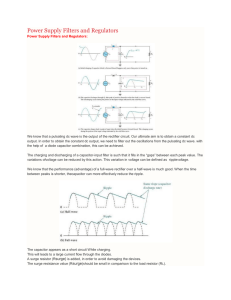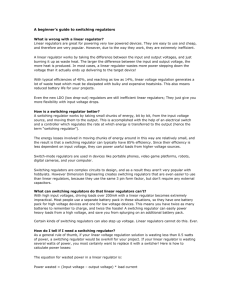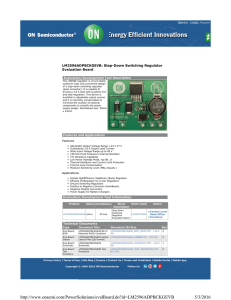
A beginner’s guide to switching regulators What is wrong with a linear regulator? Linear regulators are great for powering very low powered devices. They are easy to use and cheap, and therefore are very popular. However, due to the way they work, they are extremely inefficient. A linear regulator works by taking the difference between the input and output voltages, and just burning it up as waste heat. The larger the difference between the input and output voltage, the more heat is produced. In most cases, a linear regulator wastes more power stepping down the voltage than it actually ends up delivering to the target device! With typical efficiencies of 40%, and reaching as low as 14%, linear voltage regulation generates a lot of waste heat which must be dissipated with bulky and expensive heat sinks. This also means reduced battery life for your projects. Even the new LDO (low drop-out) regulators are still inefficient linear regulators; They just give you more flexibility with input voltage drops. How is a switching regulator better? the rate at which energy is transferred to the output (hence the term “switching regulator”). The energy losses involved in moving chunks of energy around in this way are relatively small, and the result is that a switching regulator can typically have 85% efficiency. Since their efficiency is less dependent on input voltage, they can power useful loads from higher voltage sources. Switch-mode regulators are used in devices like portable phones, video game platforms, robots, digital cameras, and your computer. Switching regulators are complex circuits to design, and as a result they aren’t very popular with hobbyists. However Dimension Engineering creates switching regulators that are even easier to use than linear regulators, because they use the same 3 pin form factor, but don’t require any external capacitors. What can switching regulators do that linear regulators can't? With high input voltages, driving loads over 200mA with a linear regulator becomes extremely impractical. Most people use a separate battery pack in these situations, so they have one battery pack for high voltage devices and one for low voltage devices. This means you have twice as many batteries to remember to charge, and twice the hassle! A switching regulator can easily power heavy loads from a high voltage, and save you from splurging on an additional battery pack. Certain kinds of switching regulators can also step up voltage. Linear regulators cannot do this. Ever. How do I tell if I need a switching regulator? As a general rule of thumb, if your linear voltage regulation solution is wasting less than 0.5 watts of power, a switching regulator would be overkill for your project. If your linear regulator is wasting several watts of power, you most certainly want to replace it with a switcher! Here is how to calculate power losses: The equation for wasted power in a linear regulator is: Power wasted = (Input voltage – output voltage) * load current For example, let’s say you have a 12V lead-acid battery and you want to power a microcontroller that draws 5mA, and an ultrasonic rangefinder that draws 50mA. Both the microcontroller and the ultrasonic rangefinder run off of 5V. You use an LM7805 (a very common linear regulator) to get the voltage down to 5V from 12V. Power wasted = (12V – 5V) * (0.050A + 0.005A) = 0.385W 0.385W is not too bad for power losses. The LM7805 can handle this without a big heatsink. You could get more battery life if you used a switching regulator, but in this case the power consumption is so low that the battery life will be very long anyway. Now let’s expand on this example, and add two servos that draw an average of 0.375A each, and also run off of the 5V supply. How much power is wasted in a linear regulator now? Power wasted = (12V – 5V) * (0.050A + 0.005A + 0.375A + 0.375A) = 5.635W 5.6 Watts is a lot of waste heat! Without a large heatsink the LM7805 would get so hot it would desolder itself or melt your breadboard or defeat Iceman. Even with the heatsink, 5.6W is also a lot of life to suck out of your battery for no reason. A switching regulator such as a DE-SW050 would be very useful in this case, and would reduce power losses to around 0.5W. Is a switching regulator really worth 10+ bucks? The final thing to consider is of course, cost. If your project is cheap and simple enough that a switching regulator would triple the cost of the entire project, then a switching regulator may be hard to justify. However if you are building a more advanced robot, airplane etc. and a switching regulator adds 15% to your cost, but gives you 35% more battery life, then it is a good deal right? I am not stupid. I know you are just trying to sell your products. Why should I buy a switching regulator from you instead of from someone else? Our regulators are light, small, efficient, have a wide input range, are clearly labeled and even easier to use than a linear regulator. They are also cheaper than other regulators with similar specifications. Plus unlike other companies, we won’t rip you off on shipping. We hate it when people do that to us! Where can I find more information on switching regulators? Try searching for “buck converter”, “boost converter” or “dc-dc converter” and you should find some good tutorials.




